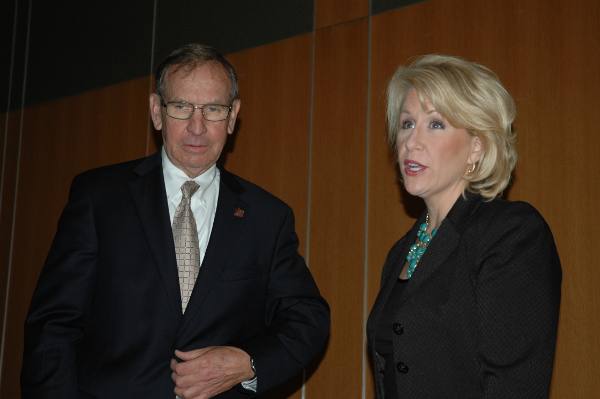
It’s an exciting time to be involved in agriculture.
Farmers and ranchers face significant opportunities but equally daunting challenges as they seek ways to double food production by 2050. Success depends on improving productivity and enhancing international trade, according to a respected agricultural economist who sees a bright future for U.S. agriculture.
“I am more optimistic about agriculture that at any time in my career,” says Dick Crowder, professor, international trade, at Virginia Tech University. “Agriculture has a huge opportunity and responsibility.” Crowder was keynote speaker at the Rural Economic Outlook Conference at Oklahoma State University in Stillwater.
Crowder, who also worked extensively in the private ag industry sector and served as chief agriculture negotiator in the Office of the U.S. Trade Representative, said maintaining the status quo will fail to double agricultural production. The limitations are real and substantial. If agriculture must double food production with perhaps 10 percent more land but less water, less labor and the same policies and technology available today, the effort will fail.
Success, he said, depends on increasing per acre yields with less waste and increased efficiency. That will require new technology, wide adoption of new policies, improved infrastructure and better management. “Intellectual property rights must be protected,” he said. “Also, in some countries, management is a limiting resource.”
Some areas, he added, especially developing nations, face serious infrastructure inadequacies, including too little storage and transportation problems.
“Can we double food production by 2050?” Crowder asked. “Yes, but we have to change. We have to thrive on change and risk.”
Technology is essential
He said with adoption of new technology, better management, and improved efficiency, “yields will go up.”
Change will include more than individual producers, however. Crowder said agriculture will require greater investments in research and development from public, private and joint efforts. Improved infrastructure and human capital also will play important roles in enhanced productivity. Those issues must become priorities at land grant universities. “We can’t become complacent.”
Adoption of new technology, especially genetically modified products, should become more synchronized so that all trading nations accept new offerings at the same time to limit delays in incorporating them into production.
On-farm changes will include higher but more volatile commodity prices. “We expect higher farm income but with greater risk.” He said farmers must “market, don’t sell. Get closer to customers.”
Producers must become active in policy leadership.
Trade becomes crucial for U.S. agriculture. “Without growth in agricultural exports, agriculture will not grow in the United States,” Crowder said.
Agriculture has become a global industry. “Demand and supply changes drive world trade,” he notes. “Opportunities exist outside the United States. That’s where 95 percent of the population is, where 96 percent of the population growth will be and where per capita food consumption will grow. We will see 1 billion new middle class customers by 2030.”
The United States already depends heavily on ag exports. From 2000 through 2010, 49.5 percent of U.S. wheat, 17.6 percent of corn, 49.3 percent of rice, 38.9 percent of soybeans and 70.3 percent of cotton was exported.
Those totals are expected to change from 2011 through 2020. Wheat exports will drop to 46 percent and corn will fall to 14.9 percent. Rice, soybean and cotton exports will increase to 53 percent, 47.3 percent and 81.3 percent, respectively.
For meat products, export percentage has increased significantly since the 1960s, from 0.2 percent for beef, 0.7 percent for pork and 2 percent for poultry from 1960 through 1969, to 6.8 percent, 13.1 percent and 16.5 percent from 2000 through 2010. Those percentages are expected to rise to 10.3 percent for beef, 22 percent for pork and 16.9 percent for pork by 2020.
Export potential faces risk, too, Crowder said. “The importance of trade for U.S. agriculture has never been greater. But the risks have increased.” Obstacles include the world economy, protectionism (tariffs and non tariff barriers), the value of the dollar, export bans, competitive decline and a lag in bilateral and regional free trade agreements.
Some protectionist policies exist because some food-insecure countries like to manage trade closely.
“Defending against protectionism is important,” Crowder said. “A push to negotiate bi-lateral agreements should be relentless. We also have opportunities within monitoring and enforcement policies. We must nurture a multilateral system. And trade promotion authority is a must.”
He said bi-lateral trade agreements increase the competitiveness of U.S. products, reduce non-tariff barriers, and level the playing field. “Benefits accrue quickly.”
The free trade agreement recently signed with South Korea will mean as much as $500 million savings for U.S. agriculture when it is fully implemented.
U.S. agriculture must maintain any competitive lead they gain in international trade. That will include protecting intellectual property rights and investing in research and development for people and infrastructure. “Trade policy must keep the playing field level,” he said. “We must remain a reliable supplier and the preferred, not the residual, supplier.”
Meeting customers’ demands with safety, security and specific services also help hold the competitive edge. “And we have to be careful not to let other countries get the first market advantage in free trade agreements.”
Crowder said agriculture must “think differently,” and become drivers of opportunity. “From today forward, agriculture will be a profitable growth industry; an increasingly global industry; increasingly high tech; a high profile, public industry; and will experience rapid growth in productivity.
“The year 2050 is pretty close,” he said.
About the Author(s)
You May Also Like






